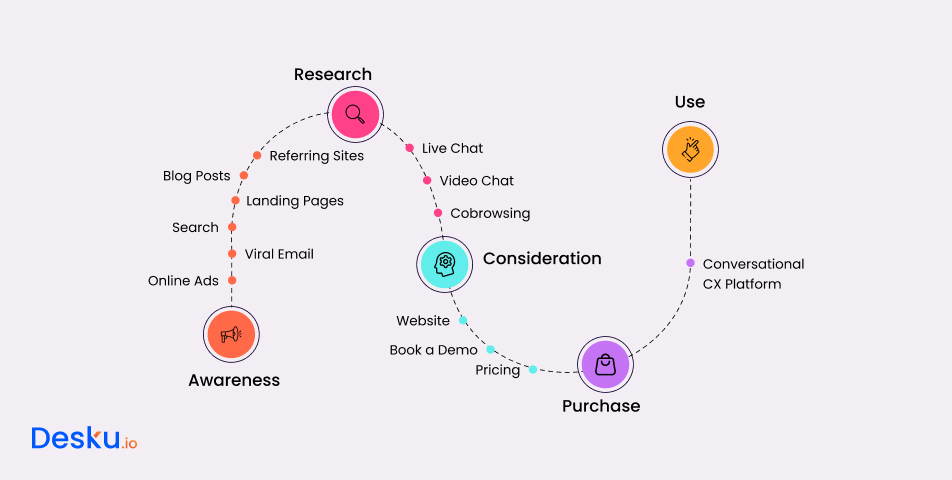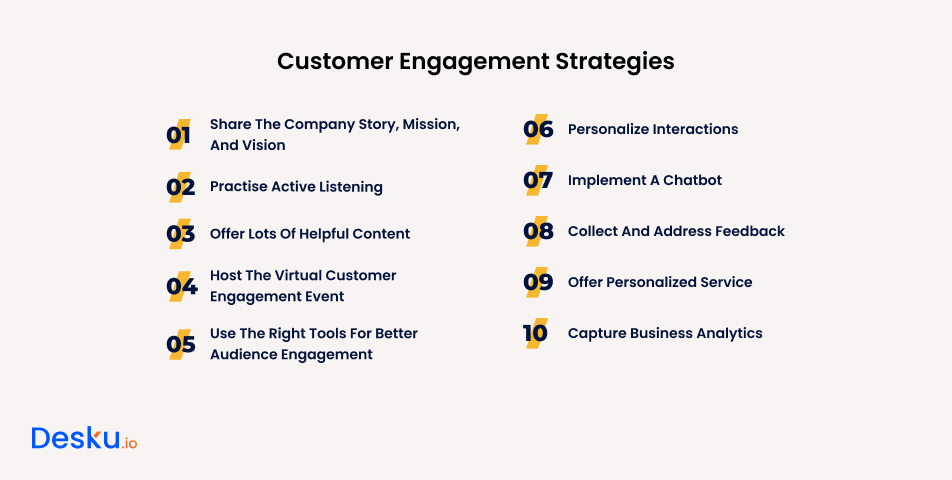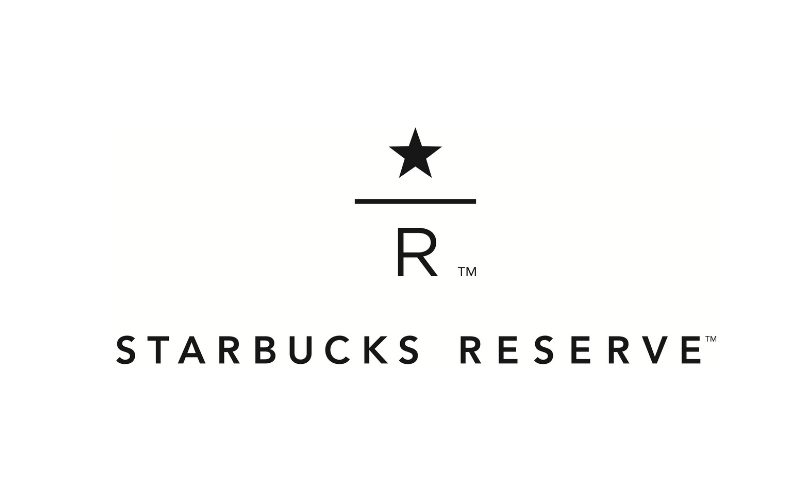Customer engagement strategies are the best if you keep the organisational vision in mind.
Customers must have a powerful vision of getting engaged with potential customers and assisting them with great customer experience all across the touchpoints, which is the primary objective of any business.
Digital customer engagement is essential when building a business strategy, leading to customer success and growth. Therefore, customer engagement is essential for a business organisation to fulfil customer expectations.
Speaking of the facts, 63 per cent of customers state that organisations should understand them better on a priority basis if they want them to be better engaged.
Customer engagement is the key to a successful business and one of the tactics that can never let your business down, but we know that you might be a little confused about what engagement tactics to exactly follow, well this blog is all about that! Let’s dive in.
Key Takeaway :
Customer engagement strategies are essential for providing better customer experiences, boosting revenue, and strengthening customer relationships. Implementing effective strategies such as personalized interactions, customer loyalty programs, and timely customer feedback can lead to improved customer loyalty, better customer experience, and increased brand value, ultimately contributing to enhanced business growth in 2024.
What is a Customer Engagement Strategy?

The customer engagement strategy is the process created to build a stronger customer base and relationships. It helps in creating the ultimate customer experience for potential customers.
The process includes manifold communication channels to improve satisfaction, nurture your customer base, and build better customer relationships.
10 Effective Customer Engagement Strategies to Implement in the Business

Your engagement strategy acts as an all-in-one solution that streamlines your customer’s interests. Their needs include:
👉🏻 What do they see as valuable?
👉🏻 What are the basic concerns of customers?
To fulfil these needs you need to create a customer-centric approach to offer your customers value and make them engage with you.
Your approach may vary depending on your customer base, sales team, and product or service. There are some strategies which help you get started:
1. Know Your Customer Journey
Knowing your customer journey is one of the best customer engagement strategies that we can see. You can not start implementing or developing an effective customer engagement plan without learning who your customers are and how they will interact with your brand.
An ideal way to begin with this is to map your customer journey and search all significant challenges, bottlenecks, and touchpoints your customers may encounter. Mapping will be beneficial in finding out more about customer behaviour and needs and also identifying various opportunities for engagement.
It is stated that almost 60% of customer calls failed because of poor data information access!
With the help of this knowledge, you may develop different ideas to engage customer profiles in the way they like.
2. Build a Customer Loyalty Program
One of the most prominent strategies to increase customer engagement is to build a customer loyalty program.
These programs act as incentives to meet loyal customers who engage with your brand through special gifts, reward points, cashback, discounts, and more.
Loyalty programs are a great way to provide an engaging customer experience that boosts your business and brand loyalty.
3. Personalised Interactions
Generic customer experiences combine into email newsletters, social shares, and noise. You want to give the user the feeling that they matter a lot to you and are not special.
The key factor behind a successful personalised experience is to listen to what the user is saying, giving them the quirky touches to link with them.
The fact about “personalisation” is that it increases the revenue by 166%. Just imagine the power of personalisation interactions with customers.
Use customer data and customer surveys to gain buyer insights and design customer interactions as per their liking that focus on preferred format, cadence, and how they are being served.
Design personalised customer experiences that let the user know you’re in tune with their interests and needs.
4. Implement a Chatbot
If you implement an AI-powered chatbot that can talk to users and analyse data, it helps in recommending products to customers or visitors. It is one of the smarter customer engagement strategies that feels original.
Another great importance of chatbots is that they benefit you in offering smooth service. It means that, even when human agents are not around, you do not lose the chance to get the customers’ attention, collect customer details so humans can reach out, or tackle questions quickly.
Read More: 11 Best AI Chatbot for your Business in 2024
5. Timely Customer Feedback and CSAT
Customer Feedback is one of the most important things considering running a business successfully. CSAT helps in knowing what your customers expect from your business and what should they do or change to make your customers happy and intact with your business forever.
There are several ways through which CSAT scores can be taken and one of them is review and ratings. Asking them what and how was your experience with them. One should always take the constructive feedback as building the business into the best ways possible and customer-centric.
Read More:7 Best Ways To Measure Customer Satisfaction In The Business
6. Identify Customer Engagement Metrics
Customer engagement metrics measure the number of user clicks on different pages of your website within a single visit (also known as “session”).
Identifying engagement metrics is essential if you’re looking for ways to engage customers in retail.
Your profits will tell whether your company will survive and get some investors who can work with you.
Some significant engagement metrics are upsells and cross-sells, social media follows, subscriptions, renewals, and newsletter sign-ups. You can go for other metrics that help in better engagement by pulling through any data from various engagement campaigns, customer surveys, and new internal software or updates.
7. Offer Conversational Service
What is conversational service? How can you make the customer service process more pleasant or efficient for agents and customers?
Conversational service is a method of helping customers that aims at creating long-term relationships.
One way is to change your attention to conversations despite interactions. It is insufficient to treat customer issues as support tickets but as a stage in their customer journey.
Changing the focus to conversations means that each time you talk to a customer, you create the same long-term customer engagement relationship.
8. Support Your Customer Service Team
Happy customer service teams improve customer engagement and create a happy customer base.
Let’s understand this with the help of an example: 73 per cent of consumers fall in love with a particular brand because of friendly customer service team members.
Front-end staff indeed plays a major role in engaging customers. Yet, most companies forget to provide support to their employees just like their customers, and that might have a huge impact on customer engagement.
So, try to incorporate one of the most effective strategies to increase your customer engagement: do support and take care of your team. Equip them with the right training and technology, reward results, and motivate them for their work.
9. Use the Right Tools to Interact with the Audience
A customer engagement platform provides you the benefit of automating and organising your strategy to increase every touchpoint in the whole process.
With the right technology and tools, you can create a great customer experience across different channels for your valuable customers and help your sales team minimise repetitive tasks and manage workflows.
Initially, manual tracking may work, but modern tools will effectively help you offer access to revenue growth and optimise activities via buyer sentiment analysis and data.
Using the right tool to interact with the customers can resolve all your queries and improve customer satisfaction.
10. Take a Social Approach
One can implement Customer engagement strategies on sites like Instagram, Facebook, and Twitter. All these platforms share their praise and express their concerns with a business.
These tools provide direct access to the customer’s raw feelings and thoughts. Report user content, provide beneficial resources, respond to comments, and show support for a cause to nurture deep and healthy relationships with customers.
The social approach is a great way to understand customers’ needs and interests that help businesses improve brand awareness, loyalty, marketing tactics, customer service, and insights, making it a crucial part of marketing strategies.
Benefits of Implementing an Effective Customer Engagement Strategies
Numerous sectors lead to Customer success, which includes workflows, digital marketing strategies, and several engagement campaign efforts.
All effective customer engagement strategies have one or the other things in common, but the main objective is to make your audience feel good, which is the only significant thing.
You can make the customer strategies effective via various resources, conversations, being available, and providing them with well-equipped training.
So, let’s understand some of the importance of customer engagement strategies:
✅ Improve Customer Loyalty
Customer loyalty is the customer’s personal experience. You can see customers are not buying anything from other brands and only rely on their favourite brands for purchasing any product or service.
Customer engagement strategies will improve customer loyalty by attracting and understanding the customer’s needs and offering them their favourite product or service every time.
✅ Better Customer Experience
Customers will only buy a product or take any service when they are fully satisfied with the product’s features and functions.
Sometimes customers have seen a huge satisfactory experience and are more likely to go for purchase, but remember you can not expect it to happen quickly.
And it may happen that customers might have to experience your brand several times before you place an order. On the contrary, only one poor experience can demotivate customers.
Here customer engagement strategies can help in providing better customer experiences by communicating with the customers, offering them quick responses, and great satisfaction when using the product.
✅ Boost Revenue
Engaged customers are the bread and butter of your business and are more loyal to your brand to purchase it rather than a customer who is disengaged.
It is also simple to upsell to customers who already rely on your product. Companies that increase customer engagement might see a 5-85 per cent rise in order size, a 22 per cent hike in cross-sell revenue, and a 38 per cent increase in upsell revenue.
✅ Strengthen Customer Relationships
If you want a customer to purchase your company’s product, it’s crucial to offer recurring purchases because it is easy to maintain a healthy relationship with existing customers as compared to a new customer.
Business is all about maintaining healthy and stronger customer relationships that run on give-and-take aspects.
Active engagement of strategies can strengthen customer relationships with new and existing customers in terms of buying a product with the company and maintaining good repo with them.
✅ Maximise Brand Value
A good customer engagement platform focuses mainly on brand value and not just the other unworthy points. A business can provide a great solution to all your customers’ related issues and is an invaluable resource. Customer engagement increases your brand value as they purchase your product and services according to their needs.
In such a way, customers become an active decision-maker, not only the one who receives the experience.
Proven Customer Engagement Examples
Considering the top brands that we all are aware of surely have some best customer engagement strategies that keep the customers intact in the business. We have listed some of the best examples for you to consider and have a reference!
Example: 1 Coca-Cola Beverages

Coca-Cola is one of the parts of our lifestyles and how? Apart from the whole product, they know how to keep the customers returning to them. Of course, they have the right engagement strategy. One of their campaigns #shareacoke campaign was run by them in the year 2011 through which they got connected with people. The campaign was all about personalisation. The common names were written on the label of the Coca-Cola sticker and people used to rush to find their name on it or even if they found their friend’s name they used to take and share it with their friends. This campaign started in Australia.
It was one of the best engagement strategies that got connected with the people and got engaged.
Example: 2 Starbucks

Starbucks is considered to be the king of Coffee and in the food business. It does not leave a chance to connect with the people, may it be writing the name on the coffee cups or some temporary marketing strategies. One of the customer engagement strategies that got the maximum people’s attention was “Starbucks Reserve Roastery” where customers and coffee enthusiasts can taste rare coffee globally, solve the mystery of the process of coffee making and everything that is related to coffee.
It makes the customers feel connected with them in their journey. Taking customers on their journey is a kind experience for them and it becomes so overwhelming that a company really cares to show how they work and Starbucks got all the attention required.
Example: 3 MacDonalds Macdelievery “Skip the Dishes”

Macdonald’s is one of the brands that strikes anybody’s mind when it comes to a “burger”. One of the huge burger outlets in the world which took the “Skip the Dishes” marketing campaign in one of the most creative ways. The signature meals of McDonald’s like burgers and french fries were taken to showcase it with the dirty dishes by creating the signature dishes. This campaign shows the importance of the Macdelivery and for the people who do not like the dirty dishes.
Guess what it worked so well and in the best ways. It helped to showcase the importance of fast and easy delivery and how it helps to have your best meals with Macdonalds.
Conclusion
We have seen various ways to increase customer engagement and how creating it will positively impact your business.
One can achieve the right customer engagement strategy in many ways, including finding effective ways to connect, creating a better customer experience, providing personalised service, social media marketing strategy, using conversational marketing, and engaging customers with insightful messaging.
And if you want to know more about customer engagement strategy through tremendous post-purchase training and service. Desku is here for you to guide you with this, so get in touch with us today!
FAQs
1. How can we improve customer engagement?
Customer engagement can be improved in manifold ways: Personalizing customer touchpoints, regularly asking for customer feedback and surveys, engaging and responding actively to customers on social media platforms, and establishing a single view of the customer to have deep knowledge about their interests and behavior.
2. Why is customer engagement important?
Customer engagement is directly related to your business health. When customers have a positive feeling and connect emotionally with your brand, they are more inclined to stay loyal, spend more, and refer your company to their colleagues or friends.
3. What are customer engagement strategies?
Any activity that boosts your business’s relationship with customers is known as a “customer engagement strategy.” Customer engagement strategy includes customer interaction, social media conversation, customer service, and email surveys.


